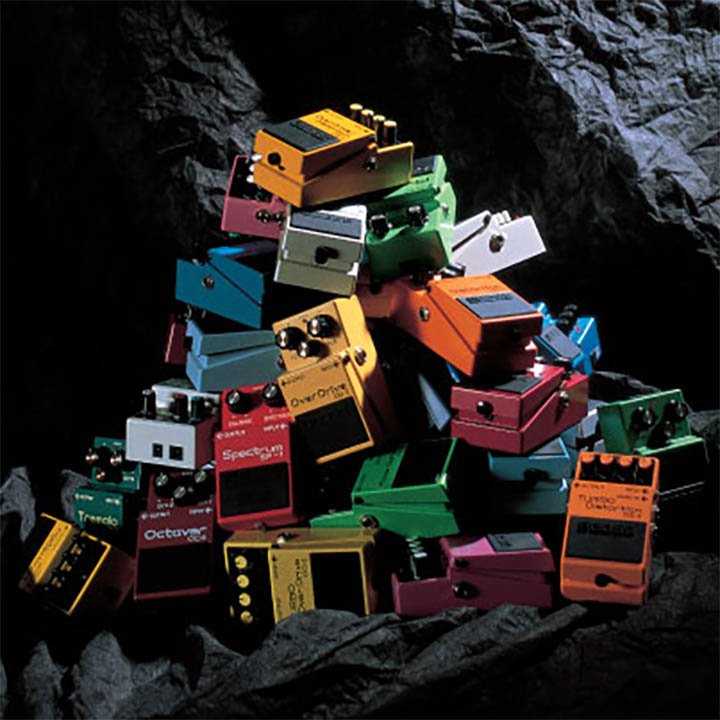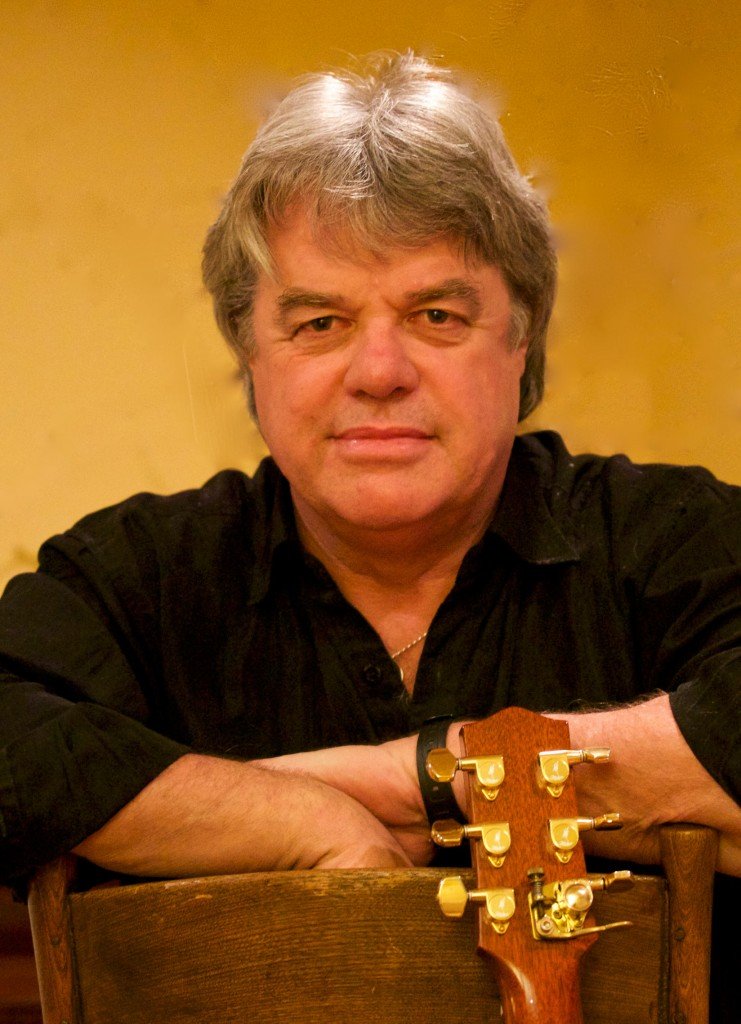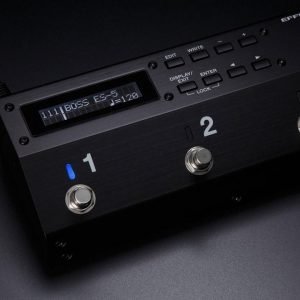As a guitarist, Steve Henderson toured Australia, SE Asia and USA. As an author, he has written for publications such as Music In Action, Guitarist Australia and Australian Guitar.
Since 1993, Steve has been teaching at the Australian Institute of Music (AIM) but has still found time to give design input into products such as Mesa/Boogie amps, Profile guitars and Maton guitars. Steve plays Maton ‘Steve Henderson’ model acoustic/electric and Godin guitars (amongst others).
Contributed by Steve Henderson
In this article Steve gives us his thought on Buffered Effects, True-Bypass and Boss Pedals.
Maybe it was back in ’63, when Leo Fender jammed one of Laurens Hammond’s reverb units into the back of his amp to create the Vibroverb…maybe it was the tremolo circuit in the ’55 Tremolux…maybe it was Sam Philips’ 1951 recording of “Rocket 88” by Jackie Brenston (actually, Ike Turner’s “Kings Of Rhythm” band) with that unheard of distorted guitar sound (caused by a damaged speaker!!!)…whatever the reason, guitarists have been messing with their tone forever, utilizing the available technology of their day, finding new ways to express their ideas or to generate new ones.
In the ‘60’s, when pedals started to be produced, nobody envisaged the array of options available today. And they certainly didn’t think that so many effects might be used at once. Since 1962’s Maestro Fuzz Tone, pedals have gradually evolved into sophisticated devices with complex features and powerful engines.
Over the last few years, we’ve seen a proliferation of small effects companies and a focus on some electronic design features that, while important to some degree, have become more like marketing catch phrases than anything else. In other words, the promotional people of certain manufacturers are focusing on a particular (often mundane) electronic design arrangement rather that the tone or functionality of the whole.
Class A…true bypass…hardwired…hand wired…buffer free…the number of these catch phrases is steadily growing, and many of our uninitiated colleagues are being seduced by these sound bites. Not that these are necessarily insignificant features – it’s just that they are only one part of the product on offer, and to buy it based on just that “feature” seems rather foolish.
For example, many “boutique” pedal companies offer buffer-free, true-bypass circuits. These are actually two different functions, both serving to maintain the integrity of the guitar tone. True-bypass (often an interchangeable term with “hardwired”) is simply the switching arrangement – step on the pedal and the circuit is completely removed from the signal path. If this pedal is also free of a built-in buffer amp, then one would think that the signal would remain true.
However, this is only true when using short cables. In the real world, our cables are probably 6m or more, and there are at least two of these (along with some short patch leads). A buffer amp simply converts the high impedance signal to a lower impedance to pass through longer cables without degrading the signal. (Remember, even with the guitar directly into the amp via a long cable, there will be some loss of treble.)
Building a buffer into a pedal can be beneficial in that, when the effect is engaged, the buffer will compensate for any signal loss in either the effect circuitry or the cable length. Many modern effect-switching systems are intentionally built with un-buffered effects but with a buffer (always on) before and after the pedals.
When using multiple pedals, too many buffered effects can create noise or a harshness of tone. Some manufacturers are designing circuits that allow the user to select whether the buffer on or off, or on even when the effect is disengaged. This allows the guitarist to select some buffered and some without – a flexibility that becomes more and more critical as the number of pedals increases.
 When Boss compact pedals were released in ’77 (they’d been preceded by larger format units – most notably the CE-1, but also the notable Boss Sustainer), the idea of chaining more than just a couple was quite foreign. So having a buffer in each pedal made a lot of sense.
When Boss compact pedals were released in ’77 (they’d been preceded by larger format units – most notably the CE-1, but also the notable Boss Sustainer), the idea of chaining more than just a couple was quite foreign. So having a buffer in each pedal made a lot of sense.
Of course, today’s pedal snobs…sorry….aficionados have, over the last few years, given the Boss range some bad press. Some of the criticism is due to the pedals not being exactly right for the individual’s circumstances; other criticism is just unreasonable bias. Boss has built some truly usable and timeless effects. For instance, even 35 years after its release, the DS-1 is still a great sound and a genuine classic.
When Boss compact pedals hit the market, they were a revelation in design and facility. During the ‘60’s and ‘70’s, pedals had been manufactured in all shapes and sizes (even within a company’s own range), and often quite shabbily constructed. MXR created a “corporate look” for their gadgets, using a simple, standardized Hammond project box and squeezing everything into that one little enclosure (yes, the Flanger, the Phase 100 and the Graphic were larger – actually, the next size box in the Hammond catalogue). But even MXR had some short-comings.
 Boss compact pedals hit the market with 1977’s OD-1 (the first overdrive pedal) and immediately became the benchmark for design, sound, circuitry and, yes, colour. Amongst the unique features on this new type of pedal: the switch was easy to hit AND it was silent (it didn’t go pop, as all other pedals did), the battery was easy to get at, the knobs couldn’t be stomped on (already a feature of earlier Boss and Roland pedals), there was an adaptor port, it had an status light (at first it just blinked as the switch was activated, then a low-current LED allowed it to remain on; the CE-1 already had LEDs but it was mains powered), volume levels didn’t drop when the effect was engaged (check out an old MXR Chorus, Flanger or Phaser), the colours allowed for identification on a dark stage, it incorporated an integrated rubber base pad, and it was bullet-proof.
Boss compact pedals hit the market with 1977’s OD-1 (the first overdrive pedal) and immediately became the benchmark for design, sound, circuitry and, yes, colour. Amongst the unique features on this new type of pedal: the switch was easy to hit AND it was silent (it didn’t go pop, as all other pedals did), the battery was easy to get at, the knobs couldn’t be stomped on (already a feature of earlier Boss and Roland pedals), there was an adaptor port, it had an status light (at first it just blinked as the switch was activated, then a low-current LED allowed it to remain on; the CE-1 already had LEDs but it was mains powered), volume levels didn’t drop when the effect was engaged (check out an old MXR Chorus, Flanger or Phaser), the colours allowed for identification on a dark stage, it incorporated an integrated rubber base pad, and it was bullet-proof.
And that cleverly-design case with which Boss has persisted – well, it’s brilliant. And, if there was any doubt about just how good it is, we need only ask the competition: Ibanez (including 1979’s TS-808, then the 9 Series, featuring 1982’s TS-9), DOD/Digitech, Rocktron, Marshall, Line 6 and, of course, Behringer…all of these companies have “created” their own versions of the Boss design.
On my various pedal boards, I have quite a number of Boss pedals, happily cohabitating with other brands such as TC, Suhr, Mesa, Creation Audio Labs. I am not the least concerned with a pedal’s spec, especially the buffer and true bypass issues, but only that it sounds good and interacts well with the other electronics.
There is a constantly expanding universe of interesting sounds out there and Boss has usually lead the way, producing interesting, creative tools for the player to individualize in his or her own way.
While other effects companies have come and gone (and some have come again), Boss has thrived for nearly 4 decades – continuing to innovate, providing new facilities, new sounds and new…er…colours.
Written by Steve Henderson









